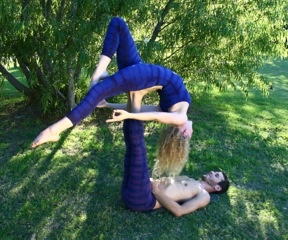
Typically the third pose taught in Acro Yoga, Back Bird (AKA Back Leaf, Back Flying) is both therapeutic and a gateway into acrobatic flying.
Base
Here foot placement varies on the flier’s low back. Much more an art than an exact science, your feet can be either parallel and centered on the flier’s buttocks or turned out with the heels on the flier’s sacrum. Some flier’s prefer the feet higher or lower, allow them to position your feet as they like. Reach your hands towards the fliers arms as best you can, bending your knees deeply. As the flier leans back and weight shifts into your legs, slide your hands up to their shoulders and straighten your legs. Here the base can control the angle of the flier’s body by extending and flexing the feet (often referred to as “more toe” and “less toe”). Check in with the flier, make sure their lower back is comfortable and that they are experiencing no pain. Adjust your foot placement as necessary until it is comfortable. (Fliers with deep sway backs or lordosis tend to feel better with the toes out approach described above). If all is well, you might slowly remove your hands from the flier’s shoulders. Again, check in. Do not allow the flier to fall backwards over your own head. Keep your hands up and/or ready to catch their shoulders as needed. When you lower the flier back to their feet, stay present with them, don’t let them fall forward!
Flier
There are several ways to enter into back bird as the flier: holding hands, holding shins, or going in hands free. First walk very close to your base such that your heels almost touch the base’s buttocks. Place their feet how you like on your buttocks/sacral area (as described above). Holding on to the base’s shins or hands (mindful of your shoulders) begin to lean back into your base’s feet. Make sure your low back is comfortable, you can ask for more toes or less toes as needed (or change foot placement). Let your arms and legs hang limply from your body (or hold on to your own ankles in bow). Especially if its your first time here come down carefully to your feet after a short time, ensure you are not dizzy.
Spotter
Standing at the side with one hand over and one hand under (but not touching) the flier’s abdominal area, touching only when needed to prevent falls or injury, staying present and aware with what the base and flier are doing, and staying out of the way as they find their balance. If they do tip, either 1) help them back to centered balance or 2) help the flier safely return to the earth always to their feet in this position. Another job for the spotter is to help guide the base and flier. If the base’s legs are not straight up and down (vertical) tell them which direction to move their feet to straighten them out. Remind the flier to keep their gaze You can also act as a go-between for communicating if flier and base can’t hear each other. As they come out of the pose help the flier stand up all the way straight as beginner’s can sometimes fall forward.